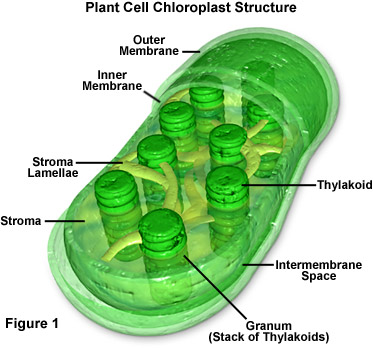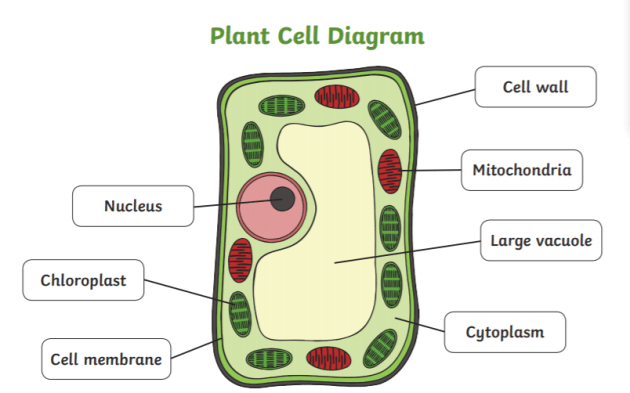do all plant cells have chloroplasts
The organelles are only found in plant cells and some protists such as algae. 10 What cell parts do animal cells have that plant cells do not have why.
Do Only Plant Cells Have Chloroplasts Quora
Many leaf and stem epidermal cells lack chloroplasts.

. 13 Are chloroplasts found in most plant cells explain. In plants and algae which developed much later photosynthesisoccurs in a specialized intracellular organellethe chloroplast. The immediate products of photosynthesis NADPH and ATP are used by the photosynthetic cells to produce many organic molecules.
Chloroplasts perform photosynthesis during the daylight hours. Chloroplasts absorb sunlight and use it in conjunction with water and carbon dioxide gas to produce food for the plant. Chloroplasts are the food producers of the cell.
All of the green structures in plants including stems and unripened fruit contain chloroplasts but the majority of photosynthesis activity in most plants occurs in the leaves. The entire process is called photosynthesis and it all depends on the little green chlorophyll molecules in each chloroplast. Another example is the meristemthe rapidly dividing undifferentiated plant tissue cells found in places where the plant can grow.
True False By signing up youll get thousands of step-by-step solutions to your homework. Chloroplasts are organelles found in plant cells and eukaryotic algae that conduct photosynthesis. These cells do not contain chloroplasts but have smaller organelles called.
Almost all plants have chloroplasts in their cells. Animal cells do not have chloroplasts. 13 Which structure is found in a plant cell but not in an animal cell circle the correct answer.
Besides the roots which you mention the trunk and branches of. Plant cells differ from animal cells in ways. When the plant is its development state they contain proplastids which may turn into chloroplasts if the cells are exposed to light.
All cells need to be able to harness energy for food and chloroplasts get their name from chlorophyll which is a green pigment used for photosynthesis giving plants their food. 14 What are the. Chloroplasts are a type of plastid that are distinguished by their green color the result of specialized chlorophyll pigments.
No most chloroplasts are in the interior cells in leaves termed the mesophyll and the cells near the surface of green stems. 10 How do the chloroplast and mitochondria work together to help a plant cell survive. Plant cells that are specialist in doing photosynthesis for the plant need to have chloroplast in them while those plant cells that do not participate in photosynthesis do not need to have chloroplast in them.
Furthermore what plant cells have chloroplasts. All plant cells have chloroplasts but only some animal cells such as green frogs have chloroplasts. It plays an important part in the survival of.
Do all plants have chloroplasts. Plant cells have chloroplasts but animal cells do not. Chloroplasts enable plants to perform photosynthesis to make food.
Because animals get sugar from the food. Do all plant cells have chloroplasts. This process occurs in almost all plant species and is carried out in specialized organelles known as chloroplasts.
The epidermis is the outermost layer of cells on nonwoody plant parts. Chloroplast converts light solar energy into chemical energy during photosynthesis while mitochondria the powerhouse of the cell produces ATP- the energy currency of the cell during respiration. 9 What are 3 differences between plants and animals.
Chloroplasts are what help the plant to capture energy from the sun to be converted into food along with chlorophyll. They are not present in all plant cells. Chloroplasts are important cell structures that give vegetation its distinctive green coloring.
Their main role is to conduct photosynthesis. 14 Do cells. They are not present in all plant cells.
12 What organelles are in plant and animal cells. The plants entire body isnt green just the green parts you can see with the naked eye - the leaves of course and sometimes stems. 11 Which organelle is common to animal and plant cells.
Other forms of plastids may play a role in storing lipids amylum or proteins and they form because there is a lack of light these are present mostly in roots. Log in for more information. Not all of the cells in a plant have chloroplasts in them.
Added 1072020 34528 AM. Plant cells need both chloroplasts and mitochondria because they perform both photosynthesis and cell respiration. Plant cells have a cell wall but animals cells do not.
In this way do all plant cells have cytoplasm. Chloroplasts transport important molecules for the cell to use. Answer 1 of 7.
A pair of guard cells surround each leaf stomata. They work along with chlorophyll to store the energy from sunlight in the storage molecules that are known as ATP and NADPH. Not all cells of the plant contain chloroplasts but they all contain some form of plastid.
This is because only the ones in which photosynthesis occurs will have chloroplasts. Plant cells have chloroplasts but animal cells do not and plant cells have cell walls but animal cells do not. In plants chloroplasts occur in all green tissues.
Similarly which type of cells in a plant normally have the most chloroplasts. For Teachers for Schools for Working Scholars for. No not all plant cells contain chloroplasts.
What do plant cells have that animal cells do not. Once the sugar is made it is then broken down by the mitochondria to make energy for the cell. Chloroplast structure within the cells of plants and green algae that is the site of photosynthesis.
No all plant cells dont contain chloroplasts. It is one of several different plastids. 12 Why chloroplast is absent in animal cell.
Guard cells usually have chloroplasts. Both animal and plant cells have mitochondria but only plant cells have chloroplasts. They are responsible for absorbing energy to feed the plant and power its growth.
Plant cells usually have one or more large vacuoles while animal cells have smaller vacuoles if any are present. All plant cells contain chloroplasts. 11 What would happen if there was no chloroplast in a plant cell.
All plants feature chloroplasts within their cells though they are not present in every cell of the plant. 9 Why are Chloroplasts useful for plant cells but not for animal cells quizlet. Chloroplasts are organelles that have a green pigment that make the plant look green.
For example onion and garlic plant cells do not have chloroplastsand neither do the underground roots of plants. Plastids are plant cell organelles that are involved in the storage and synthesis of metabolic materials. Why do all plant cells contain mitochondria but only some.
For example the cells of a plant root do not photosynthesize food for the plant and therefore absence of chloroplast in them totally makes sense.

What Is A Chloroplast Answered Twinkl Teaching Wiki
Cell Differences Plant Cells Sparknotes

Molecular Expressions Cell Biology Plant Cell Structure Chloroplasts
Do Only Plant Cells Have Chloroplasts Quora

Do All Plant Cells Contain Chloroplasts The Handy Biology Answer Book

Cell Biology Organelles Chloroplasts Wikibooks Open Books For An Open World

11 Structure And Function In Animals And Plants S8 B1 1 1 2 4 Unit 2 Lesson Ppt Download
What Are Chloroplasts And Where Are They Most Likely Found Quora
0 Response to "do all plant cells have chloroplasts"
Post a Comment